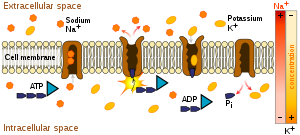Primary active transport: Difference between revisions
rm vandalism |
No edit summary |
||
| Line 2: | Line 2: | ||
'''Primary active transport''' directly uses energy to transport molecules across a membrane.<ref>{{GeorgiaPhysiology|7/7ch05/7ch05p11}}</ref> |
'''Primary active transport''' directly uses energy to transport molecules across a membrane.<ref>{{GeorgiaPhysiology|7/7ch05/7ch05p11}}</ref> |
||
Most of the enzymes that perform this type of transport are [[transmembrane ATPase]]s. A primary ATPase universal to all cellular life is the [[NaKATPase|sodium-potassium pump]], which helps maintain the [[cell potential]]. Other sources of energy for Primary active transport are [[redox]] energy and [[photon]] energy ([[light]]). An example of primary active transport using Redox energy is the mitochondrial [[electron transport chain]] that uses the reduction energy of [[NADH]] to move protons across the inner mitochondrial membrane against their concentration gradient. An example of primary active transport using light energy are the proteins involved in [[photosynthesis]] that use the energy of photons to create a proton gradient across the [[thylakoid membrane]] and also to create reduction power in the form of [[NADPH]]. |
Most of the enzymes that perform this type of transport are [[transmembrane ATPase]]s. A primary ATPase universal to all cellular life is the [[NaKATPase|sodium-potassium pump]], which helps maintain the [[cell potential]]. Other sources of energy for Primary active transport are [[redox]] energy and [[photon]] energy ([[light]]). An example of primary active transport using Redox energy is the mitochondrial [[electron transport chain]] that uses the reduction energy of [[NADH]] to move protons across the inner mitochondrial membrane against their concentration gradient. An example of primary active transport using light energy are the proteins involved in [[photosynthesis]] that use the energy of photons to create a proton gradient across the [[thylakoid membrane]] and also to create reduction power in the form of [[NADPH]]........... |
||
Revision as of 14:09, 11 October 2008

Primary active transport directly uses energy to transport molecules across a membrane.[1]
Most of the enzymes that perform this type of transport are transmembrane ATPases. A primary ATPase universal to all cellular life is the sodium-potassium pump, which helps maintain the cell potential. Other sources of energy for Primary active transport are redox energy and photon energy (light). An example of primary active transport using Redox energy is the mitochondrial electron transport chain that uses the reduction energy of NADH to move protons across the inner mitochondrial membrane against their concentration gradient. An example of primary active transport using light energy are the proteins involved in photosynthesis that use the energy of photons to create a proton gradient across the thylakoid membrane and also to create reduction power in the form of NADPH...........
ATP utilizing Primary active transport types
(1) P-type ATPase : Sodium pump, Calcium pump
(2) F-type ATPase : mitochondrial ATP synthase, Chloroplast ATP synthase
(3) V-type ATPase : vacuolar ATPase
(4) ABC (ATP Binding Cassette) transporter : MDR, CFTR, etc
